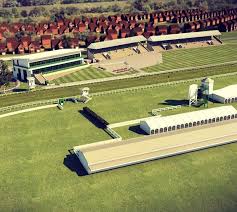The Thrill of the Race Course
Race courses are the heart and soul of motorsport events, providing a challenging and exhilarating platform for drivers to showcase their skills and push the limits of speed and precision.
These meticulously designed tracks offer a mix of tight corners, long straights, elevation changes, and various surfaces that test the capabilities of both man and machine. From Formula 1 circuits to off-road rally stages, each race course presents its own unique set of challenges that require expert navigation and split-second decision-making.
Drivers must master the nuances of each corner, optimize their racing line, and strategically overtake their competitors to claim victory. The race course becomes a battleground where adrenaline-fueled battles unfold, with spectators on the edge of their seats witnessing every heart-stopping moment.
But it’s not just about speed; race courses also demand precision and finesse. Braking points, acceleration zones, and apexes must be hit with pinpoint accuracy to gain crucial tenths of a second that can make all the difference between winning and losing.
Moreover, race courses are not just physical challenges but mental ones as well. Drivers must maintain focus and concentration throughout the race, anticipating the moves of their rivals while staying attuned to changing track conditions and weather factors.
Ultimately, the race course is where dreams are made or shattered, where champions rise to glory or face defeat. It is a place where passion meets skill, where speed meets strategy, and where every lap brings new thrills and challenges.
Understanding Race Courses: Key Questions and Insights
- What is a race course?
- How long is a typical race course?
- What are the different types of race courses?
- What makes a race course challenging for drivers?
- Are there specific rules and regulations for race courses?
- How are race courses designed and constructed?
- Do race courses have safety features in place for drivers and spectators?
- Are there famous or iconic race courses around the world?
- Can spectators attend events at a race course?
What is a race course?
A race course is a designated track or route where motorsport events take place, providing a controlled environment for drivers to compete in races. It typically consists of a series of curves, straights, and other features that challenge drivers’ skills and test the limits of their vehicles. Race courses can vary in length, layout, and surface type depending on the type of racing being conducted, such as circuit racing, rally racing, or drag racing. These courses serve as the battleground where competitors showcase their speed, agility, and tactical prowess in pursuit of victory.
How long is a typical race course?
A typical race course can vary significantly in length depending on the type of motorsport event being held. From short, tight tracks for disciplines like karting to sprawling circuits for endurance races like the 24 Hours of Le Mans, race courses come in all shapes and sizes. In Formula 1, for example, circuits range from around 3 to 7 kilometres in length, with each track presenting its own unique characteristics and challenges. The length of a race course plays a crucial role in determining the overall race strategy, as drivers must adapt their tactics to suit the demands of the circuit they are competing on.
What are the different types of race courses?
Race courses come in various forms, each designed to test the skills and abilities of drivers in different ways. Some of the most common types of race courses include road courses, oval tracks, street circuits, rally stages, and drag strips. Road courses feature a mix of straights and corners on public roads or purpose-built tracks, challenging drivers with varying turns and elevation changes. Oval tracks are circular or oval-shaped circuits where drivers navigate continuous left turns at high speeds. Street circuits are temporary tracks set up on city streets, offering a unique challenge with tight corners and limited overtaking opportunities. Rally stages take place on off-road tracks with unpredictable terrain, requiring drivers to adapt quickly to changing conditions. Drag strips are straight-line tracks where competitors race side-by-side in a test of acceleration and speed. Each type of race course presents its own set of challenges and thrills for both drivers and spectators alike.
What makes a race course challenging for drivers?
A race course presents a multitude of challenges for drivers, making it a true test of skill and precision. The layout and design of the track, including sharp corners, elevation changes, and varying surfaces, require drivers to adapt quickly and navigate with utmost accuracy. Finding the optimal racing line to maintain speed while controlling the vehicle becomes crucial in gaining an edge over competitors. Additionally, factors such as changing weather conditions, tire wear, and track grip levels add further complexity to the challenge. Drivers must demonstrate not only raw speed but also strategic decision-making and mental resilience to conquer the demanding nature of a challenging race course.
Are there specific rules and regulations for race courses?
When it comes to race courses, adherence to specific rules and regulations is paramount to ensure safety, fairness, and consistency in motorsport events. Governing bodies such as the FIA (Fédération Internationale de l’Automobile) and local motorsport authorities set guidelines regarding track design, safety barriers, pit lane procedures, flag signals, and more. These regulations aim to standardise track conditions across different venues, uphold driver and spectator safety, and maintain the integrity of competitions. Race organisers must comply with these rules to obtain necessary permits and ensure that events run smoothly and professionally. By following established regulations for race courses, the motorsport community can enjoy thrilling races while prioritising safety and fair competition.
How are race courses designed and constructed?
Race courses are meticulously designed and constructed to provide a challenging yet safe environment for motorsport events. The process typically involves a team of experienced track designers and engineers who carefully plan the layout, taking into account factors such as track length, corner radii, elevation changes, and run-off areas. The design must adhere to strict safety standards to protect both drivers and spectators. Once the layout is finalised, construction begins, with crews working to grade the terrain, lay down asphalt or other suitable surfaces, and install safety barriers and facilities. Every aspect of the race course’s design and construction is crucial in creating a dynamic and competitive racing environment that tests the skills of drivers while prioritising their safety.
Do race courses have safety features in place for drivers and spectators?
Race courses are equipped with a range of safety features to ensure the well-being of both drivers and spectators. From safety barriers and run-off areas to marshal posts and medical facilities, race organisers take extensive measures to minimise risks and respond swiftly in case of emergencies. Safety briefings, strict regulations, and regular inspections further enhance the overall safety standards at race courses. For spectators, designated viewing areas, crowd control measures, and emergency evacuation plans are implemented to provide a secure environment for enjoying the adrenaline-fuelled action on the track. Overall, race courses prioritise safety as a fundamental aspect of their operations to promote a secure and enjoyable experience for all involved.
Are there famous or iconic race courses around the world?
Yes, there are numerous famous and iconic race courses around the world that have left a lasting impact on motorsport history. From the legendary Circuit de Monaco, known for its narrow streets and prestigious Monaco Grand Prix, to the historic Nürburgring in Germany with its challenging Nordschleife track, these circuits have become synonymous with speed, skill, and adrenaline-fueled competition. Other iconic race courses include Silverstone in the UK, Suzuka Circuit in Japan, Spa-Francorchamps in Belgium, and the Indianapolis Motor Speedway in the United States. Each of these tracks has hosted some of the most memorable races in motorsport history and continues to attract racing enthusiasts from around the globe.
Can spectators attend events at a race course?
Yes, spectators can often attend events at a race course, depending on the specific event and venue. Many race courses welcome fans to come and witness the excitement of motorsport up close. Spectators can enjoy the thrill of watching races, cheering on their favourite drivers, and soaking up the atmosphere of the event. Some race courses offer grandstands, viewing areas, hospitality packages, and other amenities to enhance the spectator experience. It’s advisable to check with the race course or event organisers for information on ticketing, entry requirements, and any guidelines for spectators attending races.
Tags: acceleration zones, accuracy, adrenaline-fueled battles, apexes, braking points, challenges, champions rise to glory, concentration, corners, decision-making, drivers, elevation changes, focus, motorsport events, navigation, precision, race course, skills, spectators, speed, straights, surfaces, tracks, victory
